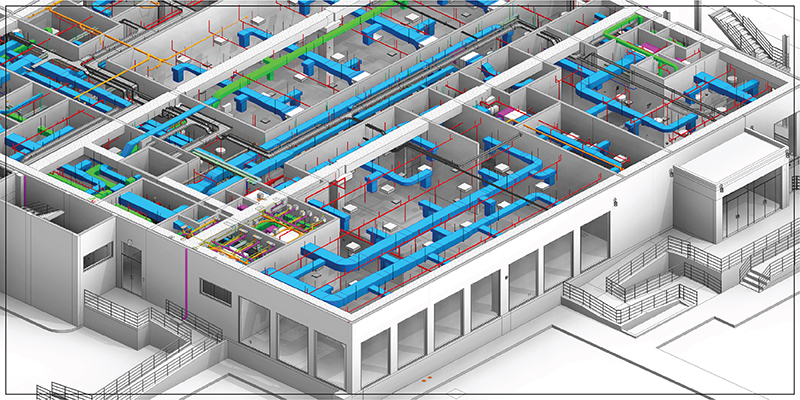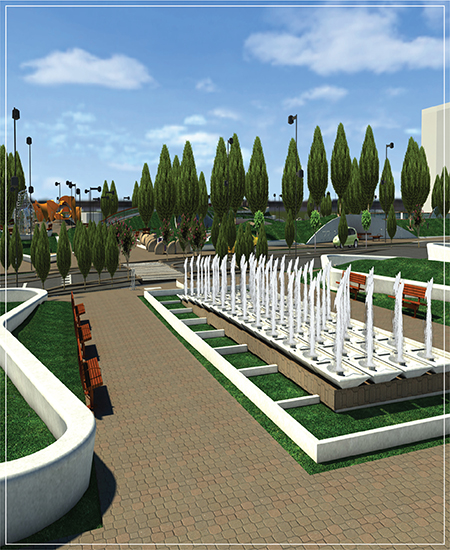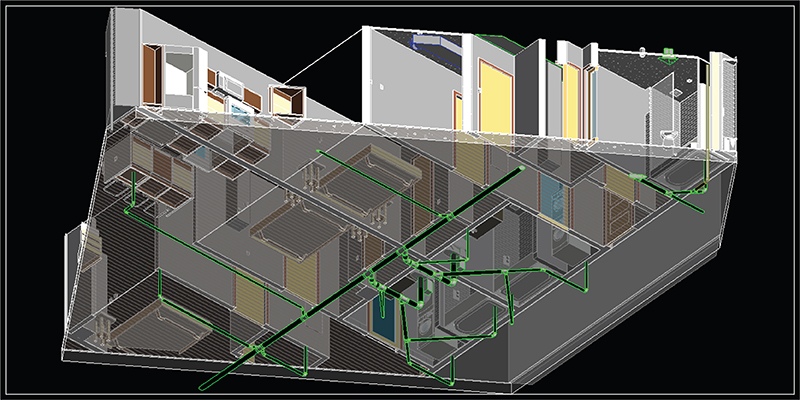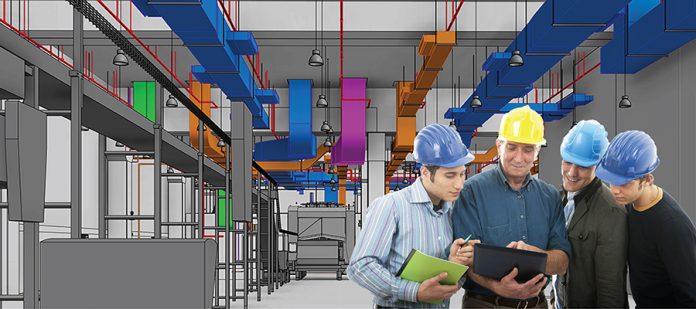A modern way to design, build and manage construction projects – or a compulsion? We take a peek into how 3D modelling and spatial coordination for MEP contractors can create greater business opportunities
Ever since traditional building design and construction were replaced by CAD-based tools, AEC professionals have been searching for efficient processes and tools to leverage information.
Simplistic CAD-based 2D design has evolved to accurate and information-rich 3D models enriched with AR/VR walkthroughs capable of meticulous visualisation of building components.
The idea of spatial coordination was predominant for architects and architectural firms to build 2D plans for trades to collaborate and work upon. Realising the depth of “complete design” through paper-based drawings and coordination between various design components was considered a pronounced ability. In the last two decades, these blueprints were scattered everywhere at installation sites, rolled out on tables, and stashed in meeting rooms.
Meanwhile, the impression of BIM 3D modelling and spatial coordination for MEP contractors has eliminated challenges to create a positive impact. This model-based approach has improved design and construction effectiveness providing economic benefits through inter-disciplinary coordination and interference-free installation of MEP systems.
While connecting MEP elements was challenging earlier, MEP BIM model coordination reinforced with graphical visualisation drives greater constructability, data exchange, streamlined documentation, and clash-free installation.
The times have consistently been evolving….
With legacy methods, computer-aided design (CAD) would be the preferred tool to communicate design intent among stakeholders. In fact in the ’90s, CAD was a predominant winner in architectural design. Primarily, the pace at which designers could produce CAD-based drawings was the driving factor for architects to adopt this new tool.
With the improvement in technology, 3D modelling made it possible for architects and contractors to see designs in a three-dimensional view. Yet, 3D CAD was restrained by its “static capabilities”, wherein the model would require exhaustive rework for a single design alteration. This led to higher labour requirements and bigger design flaws in subsequent design iterations.
Make way for BIM 3D Modelling and Spatial Coordination
For current design and construction, however, the trend has drifted toward BIM as the new standard for architects and MEP contractors. When it comes to “visualising the entire design”, and managing information in the 3D model, there is no tool that can rival BIM. The speciality of BIM lies in its capability to encapsulate design element data enriched with parametric modelling abilities. Its power lies in accurately moulding a 3D model with the smallest alterations with capabilities to reflect it in the entire model without rework and errors.
Reinforcing the preconstruction stage with precision 3D modelling has enabled MEP trades to diminish “bunkered” or “siloed” workflows. 3D BIM models supplemented with the information on time (4D), cost (5D), sustainability (6D), and other dimensions have made tradespeople cognizant of the “greater picture”.
Contractors and construction firms speak out…
A general contractor from Muscat, Oman has been using MEP BIM modelling for its infrastructure construction projects. On an airport construction project, multiple IFC drawings and architectural and structural BIM models were coordinated into a single and clash-free Autodesk Revit 3D model. Early engagement in the preconstruction stage provided better opportunities to leverage BIM data to identify and resolve clashes, reduce RFIs, and gain an accurate material count.
During construction, the general contracting firm overlaid the 3D models with model-extracted construction drawings to reduce field conflicts. The team used Autodesk Revit and Autodesk Navisworks to author and audit 3D models. “The final MEP 3D models saved $7 million in 6 months”, according to one of the spokespersons of the General Contracting company.

Accurate and spatially coordinated designs guide preconstruction
Architects, designers, contractors, and other stakeholders draw in higher communication and collaboration in the early stages. This has opened new opportunities for many contracting firms.
“For the contractor, design alterations, schedule conflicts, flawed field conditions, greater RFIs, and change orders, have led to cost overages.”
Inspired MEP contractors have identified and begun tapping benefits through the BIM adoption process in the preconstruction stage. For major construction projects, BIM capabilities have been put forth as a part of the bidding process, and a strong BIM handover drives improved facilities management.
BIM 3D modelling and spatial coordination are finding applications outside buildings. On the Santa Monica Civic Centre Parks, Palisades Garden Walk, and Town Square project, a construction firm used a BIM modelling process. Integrating PDF files and IFC drawings into one single Revit 3D model eliminated clashes. Based on AIA standards, architectural creativity was upheld in the coordinated 3D model.
The construction firm was provided with a BIM LOD 300 model, so they could extract accurate quantities through precise BOQs and BOMs. “It helped us reduce rework and potential material waste through complete clash-elimination”, according to one of the team members.

BIM and Prefabrication – An alliance created for winning projects
The fabrication industry owes its gratitude to Building Information Modeling (BIM). It has been one of the most significant tools to propel global prefabrication. For MEP contractors to capitalise on controlled or offsite fabrication and assembly, there has to be common ground that takes into account a highly spatially coordinated layout with detailed element data. With tight deadlines, the adoption of prefabrication for manufacturing and installation is paramount.
MEP Contractors know prefabrication is an integral part of their work scope. IFC and shop drawings extracted from spatially coordinated BIM models help prefabrication partners and contractors get the job done correctly. The impact of BIM prefabrication was evident on a recent residential building construction project in the US.
An architectural engineering firm broke ground to navigate around challenges to enable swift fabrication and erection, it knew prefabrication was an integral part of the workflow. With tight timelines and amidst various challenges, seamless prefabrication and installation were achieved, reducing rework and costs.
Thanks to BIM capabilities and experienced prefabrication partnerships, the residential building construction project could realise the complete potential of prefabrication.

BIM should no longer be a compulsion…but a logical and driving necessity
Previously, designers and MEP contractors would encounter projects that did not include unique BIM needs. In those projects, BIM was never a part of the official agenda. It does not occur anymore. Any fast-track or large construction project includes the necessity of BIM 3D modelling and spatial coordination to quickly identify potential errors and proactively navigate around costly rework.
All contractors need to converge early in the design stage and participate to finalize the BIM model. Gaining efficiencies within the AEC fraternity requires BIM as a critical ingredient to plan, design, build and manage present-day construction.
Spatial coordination being extensive incorporates several aspects of project delivery, team building, BEPs, process and document management, contract language, etc. While AEC firms have experienced and will continue to experience BIM success, MEP contractors will continue to face new challenges on how to conduct business in the future. This illustrates the need for contractors to embrace new processes and tools that bring positive construction outcomes enriched with economies of scale.
Bhavesh Umraniya

BIM Manager
Twitter: @hitechcadd
LinkedIn: Hitech CADD Services
Instagram: @hitechcadd














